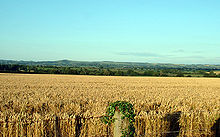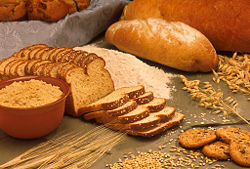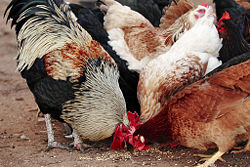Cereal
- "Grain" redirects here.
- This article is about cereals in general. For the breakfast food, see Breakfast cereal.
Cereal crops or grains are mostly grasses cultivated for their edible grains or a fruit seeds (i.e., botanically a type of fruit called a caryopsis). Cereal grains are grown in greater quantities and provide more energy worldwide than any other type of crop; they are therefore staple crops. They are also a rich source of carbohydrate. In some developing nations, grain constitutes practically the entire diet of poor people. In developed nations, cereal consumption is more moderate but still substantial.
The word 'cereal' derives from 'Ceres', the name of the pre-Roman goddess of harvest and agriculture. Grains are traditionally called corn in the United Kingdom and Ireland, though that word became specified for maize in the United States, Canada, New Zealand, and Australia.
Production
The following table shows annual production of major cereal grains, in 1961,[1] 2005 and 2006, ranked by 2006 production.[2] All but buckwheat and quinoa are true grasses (these two are pseudocereals).
| Grain | 2006 (Mt) | 2005 (Mt) | 1961 (Mt) | |
|---|---|---|---|---|
| Maize | 695,287,651 | 712,877,757 | 205,004,683 | A staple food of peoples in North America, South America, and Africa and of livestock worldwide; often called "corn" or "Indian corn" in North America, Australia, and New Zealand. |
| Rice[3] | 634,575,804 | 631,508,532 | 284,654,697 | The primary cereal of tropical regions |
| Wheat | 605,256,883 | 628,697,531 | 222,357,231 | The primary cereal of temperate regions |
| Barley | 138,704,379 | 141,334,270 | 72,411,104 | Grown for malting and livestock on land too poor or too cold for wheat |
| Sorghum | 56,525,765 | 59,214,205 | 40,931,625 | Important staple food in Asia and Africa and popular worldwide for livestock |
| Millets | 31,783,428 | 30,589,322 | 25,703,968 | A group of similar but distinct cereals that form an important staple food in Asia and Africa. |
| Oats | 23,106,021 | 23,552,531 | 49,588,769 | Formerly the staple food of Scotland and popular worldwide for livestock |
| Rye | 13,265,177 | 15,223,162 | 35,109,990 | Important in cold climates |
| Triticale | 11,338,788 | 13,293,233 | 0 | Hybrid of wheat and rye, grown similarly to rye |
| Buckwheat | 2,365,158 | 2,078,299 | 2,478,596 | Used in Europe and Asia. Major uses include various pancakes and groats |
| Fonio | 378,409 | 363,021 | 178,483 | Several varieties of which are grown as food crops in Africa |
| Quinoa | 58,989 | 58,443 | 32,435 | Pseudocereal, grown in the Andes |
Maize, wheat and rice, between them, accounted for 87% of all grain production, worldwide, and 43% of all food calories in 2003.[2] Other grains that are important in some places, but that have little production globally (and are not included in FAO statistics), include:
- Teff, popular in Ethiopia but scarcely known elsewhere. This ancient grain is a staple in Ethiopia. It is high in fiber and protein. Its flour is often used to make injera. It can also be eaten as a warm breakfast cereal similar to farina with a chocolate or nutty flavor. Its flour and whole grain products can usually be found in natural foods stores.
- Wild rice, grown in small amounts in North America
- Amaranth, ancient pseudocereal, formerly a staple crop of the Aztec Empire
- Kañiwa, close relative of quinoa
Several other species of wheat have also been domesticated, some very early in the history of agriculture:
- Spelt, a close relative of common wheat
- Einkorn, a wheat species with a single grain
- Emmer, one of the first crops domesticated in the Fertile Crescent
- Durum, the only tetraploid species of wheat currently cultivated, used to make semolina
Farming

While each individual species has its own peculiarities, the cultivation of all cereal crops is similar. All are annual plants; consequently one planting yields one harvest. Wheat, rye, triticale, oats, barley, and spelt are the cool-season cereals. These are hardy plants that grow well in moderate weather and cease to grow in hot weather (approximately 30 °C but this varies by species and variety). The other warm-season cereals are tender and prefer hot weather.
Barley and rye are the hardiest cereals, able to overwinter in the subarctic and Siberia. Many cool-season cereals are grown in the tropics. However, some are only grown in cooler highlands, where it may be possible to grow multiple crops in a year.
Planting
The warm-season cereals are grown in tropical lowlands year-round and in temperate climates during the frost-free season. Rice is commonly grown in flooded fields, though some strains are grown on dry land. Other warm climate cereals, such as sorghum, are adapted to arid conditions.
Cool-season cereals are well-adapted to temperate climates. Most varieties of a particular species are either winter or spring types. Winter varieties are sown in the autumn, germinate and grow vegetatively, then become dormant during winter. They resume growing in the springtime and mature in late spring or early summer. This cultivation system makes optimal use of water and frees the land for another crop early in the growing season. Winter varieties do not flower until springtime because they require vernalization (exposure to low temperature for a genetically determined length of time). Where winters are too warm for vernalization or exceed the hardiness of the crop (which varies by species and variety), farmers grow spring varieties. Spring cereals are planted in early springtime and mature later that same summer, without vernalization. Spring cereals typically require more irrigation and yield less than winter cereals.
Harvest
Once the cereal plants have grown their seeds, they have completed their life cycle. The plants die and become brown and dry. As soon as the parent plants and their seed kernels are reasonably dry, harvest can begin.
In developed countries, cereal crops are universally machine-harvested, typically using a combine harvester, which cuts, threshes, and winnows the grain during a single pass across the field. In developing countries, a variety of harvesting methods are in use, from combines to hand tools such as the scythe or cradle.
If a crop is harvested during wet weather, the grain may not dry adequately in the field to prevent spoilage during its storage. In this case, the grain is sent to a dehydrating facility, where artificial heat dries it.
In North America, farmers commonly deliver their newly harvested grain to a grain elevator, a large storage facility that consolidates the crops of many farmers. The farmer may sell the grain at the time of delivery or maintain ownership of a share of grain in the pool for later sale.
Food value
Cereal grains supply most of their food energy as starch. They are also a significant source of protein, though the amino acid balance, with exceptions as noted below, is not optimal. Whole grains (see below) are good sources of dietary fiber, essential fatty acids, and other important nutrients.
Rice is eaten as cooked entire grains, although rice flour is also produced. Oats are rolled, ground, or cut into bits (steel-cut oats) and cooked into porridge. Most other cereals are ground into flour or meal, which is milled. The outer layers of bran and germ are removed (see seed). This lessens the nutritional value but makes the grain more resistant to degradation and makes the grain more appealing to many palates. Health-conscious people tend to prefer whole grains, which are not milled. Overconsumption of milled cereals is sometimes blamed for obesity. Milled grains do keep better because the outer layers of the grains are rich in rancidity-prone fats. The waste from milling is sometimes mixed into a prepared animal feed.
Once (optionally) milled and ground, the resulting flour is made into bread, pasta, desserts, dumplings, and many other products. Besides cereals, flour is sometimes made from potatoes, chestnuts and pulses (especially chickpeas, which is known as besan).
Cereals are the main source of energy providing about 350 kcal per 100 grams. Cereal proteins are typically poor in nutritive quality, being deficient in essential amino acid lysine. The proteins of maize are particularly poor, being deficient in lysine and tryptophan (a precursor of niacin). Rice proteins are richer in lysine than other common cereal proteins and for this reason, rice protein is considered to be of better quality. Rice is a good source of B group vitamins, especially thiamine. It is devoid of vitamins A, D, C and is a poor source of calcium and iron.
Certain grains, including quinoa, buckwheat, and grain amaranth (Pseudocereal, non-grasses), are exceptionally nutrious. Quinoa was classified as a "supercrop" by the United Nations because of its high protein content (12-18%).[citation needed] Quinoa contains a balanced set of essential amino acids for humans, making it an unusually complete source of protein in plants.
In English, cold breakfast cereals, as opposed to cooked porridges such as oatmeal, are simply called cereal.
Notes
External links
All links retrieved December 16, 2007
- Home Grown Cereals Authority website. Retrieved 2006-09-08.
- Cereals by the Vegetarian Society
- Nutrition Facts on hundreds of cereal
| |||||
Credits
New World Encyclopedia writers and editors rewrote and completed the Wikipedia article in accordance with New World Encyclopedia standards. This article abides by terms of the Creative Commons CC-by-sa 3.0 License (CC-by-sa), which may be used and disseminated with proper attribution. Credit is due under the terms of this license that can reference both the New World Encyclopedia contributors and the selfless volunteer contributors of the Wikimedia Foundation. To cite this article click here for a list of acceptable citing formats.The history of earlier contributions by wikipedians is accessible to researchers here:
The history of this article since it was imported to New World Encyclopedia:
Note: Some restrictions may apply to use of individual images which are separately licensed.


